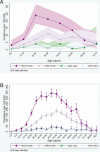Population-based incidence and prevalence of systemic lupus erythematosus: the Michigan Lupus Epidemiology and Surveillance program
- PMID: 24504809
- PMCID: PMC4198147
- DOI: 10.1002/art.38238
Population-based incidence and prevalence of systemic lupus erythematosus: the Michigan Lupus Epidemiology and Surveillance program
Abstract
Objective: To estimate the incidence and prevalence of systemic lupus erythematosus (SLE) in a sociodemographically diverse southeastern Michigan source population of 2.4 million people.
Methods: SLE cases fulfilling the American College of Rheumatology classification criteria (primary case definition) or meeting rheumatologist-judged SLE criteria (secondary definition) and residing in Wayne or Washtenaw Counties during 2002-2004 were included. Case finding was performed from 6 source types, including hospitals and private specialists. Age-standardized rates were computed, and capture-recapture was performed to estimate underascertainment of cases.
Results: The overall age-adjusted incidence and prevalence (ACR definition) per 100,000 persons were 5.5 (95% confidence interval [95% CI] 5.0-6.1) and 72.8 (95% CI 70.8-74.8). Among females, the incidence was 9.3 per 100,000 persons and the prevalence was 128.7 per 100,000 persons. Only 7 cases were estimated to have been missed by capture-recapture, adjustment for which did not materially affect the rates. SLE prevalence was 2.3-fold higher in black persons than in white persons, and 10-fold higher in females than in males. Among incident cases, the mean ± SD age at diagnosis was 39.3 ± 16.6 years. Black SLE patients had a higher proportion of renal disease and end-stage renal disease (ESRD) (40.5% and 15.3%, respectively) as compared to white SLE patients (18.8% and 4.5%, respectively). Black patients with renal disease were diagnosed as having SLE at younger age than white patients with renal disease (mean ± SD 34.4 ± 14.9 years versus 41.9 ± 21.3 years; P = 0.05).
Conclusion: SLE prevalence was higher than has been described in most other population-based studies and reached 1 in 537 among black female persons. There were substantial racial disparities in the burden of SLE, with black patients experiencing earlier age at diagnosis, >2-fold increases in SLE incidence and prevalence, and increased proportions of renal disease and progression to ESRD as compared to white patients.
© 2014 The Authors. Arthritis & Rheumatology is published by Wiley Periodicals, Inc. on behalf of the American College of Rheumatology.
Figures




Comment in
-
Editorial: Updates in US systemic lupus erythematosus epidemiology: Tales of two cities.Arthritis Rheumatol. 2014 Feb;66(2):242-5. doi: 10.1002/art.38240. Arthritis Rheumatol. 2014. PMID: 24504794 No abstract available.
References
-
- McCarty DJ, Manzi S, Medsger TA, Jr, Ramsey-Goldman R, LaPorte RE, Kwoh CK. Incidence of systemic lupus erythematosus: race and gender differences. Arthritis Rheum. 1995;38:1260–70. - PubMed
-
- Centers for Disease Control and Prevention. National Center for Health Statistics Postcensal estimates of the resident population of the United States for July 1, 2000-July 1, 2009, by year, county, age, bridged race, Hispanic origin, and sex (Vintage 2009). Prepared under a collaborative arrangement with the US Census Bureau. URL: http://www.cdc.gov/NCHS/nvss/bridged_race.htm.
-
- Lim SS, Drenkard C, McCune WJ, Helmick CG, Gordon C, DeGuire P, et al. Population-based lupus registries: advancing our epidemiologic understanding. Arthritis Rheum. 2009;61:1462–6. - PubMed
-
- US Census Bureau. United States Census Residence rules: facts about Census 2000 residence rules. 2000 URL: http://www.census.gov/population/www/censusdata/resid_rules.html.
Publication types
MeSH terms
Grants and funding
LinkOut - more resources
Full Text Sources
Other Literature Sources
Medical

